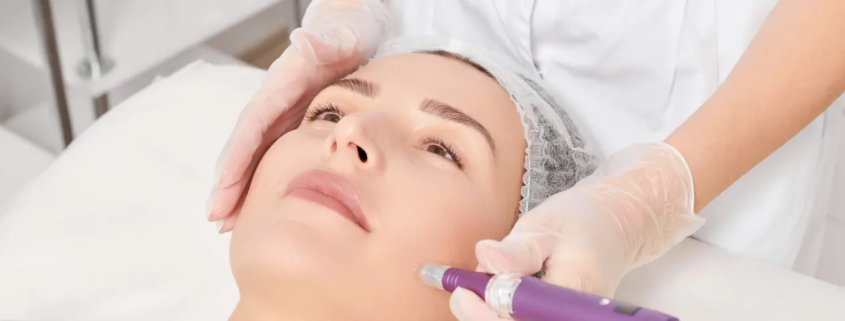The Ultimate Guide to Microneedling Before and After
Introduction
Microneedling process is a new and effective skin treatment that doesn’t need surgery. It’s gaining lots of attention for how it improves various skin problems. This guide explains how this procedure improves your skin appearance and health.
What is Microneedling?
This procedure helps improve skin by using tiny needles to create small punctures. These punctures increase the skin’s natural healing ability and reduce wrinkles. It’s like a natural boost for your skin’s vitality.
The Science Behind Microneedling!
It works by increasing the production of collagen, a protein that keeps skin firm and elastic. This process activates the skin’s natural wound healing ability. Growth factors and higher collagen levels refresh the skin and create amazing changes.
Benefits of Microneedling Before And After
Skin Texture and Appearance Transformation:
1. It leads to a transformation in skin texture and appearance.
2. Produce collagen and elastin fibers more, resulting in smoother and more youthful-feeling skin.
3. The skin’s appearance becomes more radiant and the skin feels rejuvenated.
4. People also call this process collagen induction therapy (CIT). It triggers natural healing and skin rejuvenation.
Reduction of Fine Lines and Wrinkles:
1. It stimulates collagen production deep within the skin and reduces stretch marks.
2. Reinforces collagen and elastin fibers, making the skin supple and plump.
3. Reduced fine lines and wrinkles are noticeable.
Acne Scar Improvement:
1. It is great for improving acne scars.
2. The tiny needles make small controlled injuries that help produce collagen.
3. Collagen helps fill and smooth out acne scars.
Addressing Hyperpigmentation:
1. It improves uncommon dark skin spots and uneven skin tones.
2. It triggers the skin’s natural healing process. Thus old pigmented cells shed and new evenly toned cells appear.
The Microneedling Before and After Procedure:
It is a non-invasive treatment designed to improve the appearance and health of the skin. Here’s what you can expect from the process:
1. Preparation: Before the procedure begins, your skincare professional will clean your skin. They will also apply a numbing cream to reduce any potential discomfort.
2. Microneedling Device: During the procedure, experts use a device with small, sterile needles. This creates controlled micro-injuries to the chosen area on the skin’s surface.
3. Stimulation of Healing: These micro-injuries trigger the body’s natural healing response. As the skin works to repair itself, collagen and elastin production increases. It leads to improved skin texture, firmness, and appearance.
4. Product Application: In some cases, experts immediately apply beneficial serums or skincare products. The micro-channels created during the procedure have a special role. They allow these products to penetrate deeper into the skin, enhancing their effectiveness.
5. Recovery: After the procedure, your skin might appear a bit red. This is a normal reaction and subsides within a day or two. It’s important to follow post-procedure care instructions. These instructions may include avoiding direct sun exposure and using gentle skincare products.
6. Results: Over the next few weeks, you will begin to see enhancements in your skin’s texture and quality. For the best results, experts might suggest a series of sessions, spaced a few weeks apart.
Microneedling Before and After Side Effects:
1. Temporary Redness: After the procedure, you may experience temporary redness and mild swelling. This usually fades within a couple of days.
2. Bruising: You might see slight bruising or pinpoint bleeding at the treatment site. This is usually uncommon and minor.
3. Infection Risk: You need to follow proper aftercare to reduce infection risk. It’s important to keep the treated area clean. Avoid exposing it to unclean environments.
4. Skin Conditions: Individuals with certain skin conditions should approach microneedling cautiously. For example, those with active acne or eczema should take special care. The procedure could worsen these conditions.
5. Hyperpigmentation: It can occur as a rare instance following microneedling. This is more likely to happen particularly in individuals with darker skin tones. This usually resolves over time.
6. Discomfort: Before the procedure, experts apply numbing creams. However, some individuals might still feel mild discomfort during the treatment. It’s generally well-tolerated, but pain thresholds vary.
7. Post-Procedure Care: Adhering to post treatment instructions is essential to reduce risks. Avoiding direct sunlight, using recommended skincare products, and following guidelines may reduce complications.
Combining Microneedling With Other Treatments
Combining microneedling with other treatments can make your skin look even better. This is a combination therapy.
For example, you may opt for microneedling with serums or platelet-rich plasma therapy. Sometimes, they use radiofrequency microneedling, which uses small needles and radiofrequency energy. These treatments work together to make acne spots or scars look better. When they team up, your skin can appear brighter and more youthful.
Although, it’s a good idea to talk to a skin expert first. They can recommend the best combination of treatments for your skin.
Consultation and Personalised Approach
In a consultation, a skincare expert will analyze your skin type, concerns, and goals. Sometimes, they even suggest a DNA test. Individuals’ response to treatment varies due to their unique skin type and texture. Microneedling before and after results can vary as well. People choose to do a skin DNA test because it gives them personalized advice. With this information, you can pick the right products and treatments that work for your skin.
Conclusion
To sum up, this treatment shows a great story of how it can make skin better. It improves skin texture, makes lines smaller, and helps with acne scars, and uneven skin color.
As technology gets better and we learn more, this procedure could do even better for our skin. Each tiny needle and treatment could bring big changes.
Learn more about the SkinLife DNA test.





